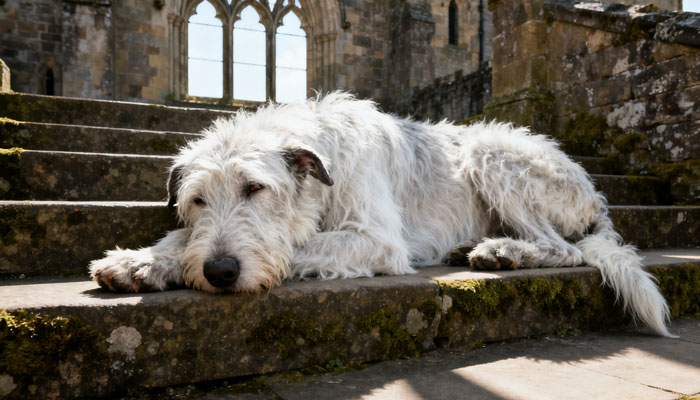Advantages and Disadvantages of the Irish Wolfhound

The Irish Wolfhound is an ancient large breed originating from Ireland, whose towering stature and long history garner significant attention among canine enthusiasts. Once prized for its exceptional hunting prowess in pursuing wolves, deer, and other large game, it now predominantly enters people’s lives as a family companion dog. However, owning an Irish Wolfhound is not without its considerations. While they possess commendable strengths, there are also shortcomings that require special attention from owners.
I. Advantages of the Irish Wolfhound
1. Temperament
Despite its imposing stature—standing over 90 cm at the shoulder and often weighing more than 50 kg, making it a true giant among dogs—the Irish Wolfhound possesses a gentle and peaceful nature. They demonstrate remarkable patience with family members, even consciously moderating their movements around children. Aggressive behavior is exceptionally rare, making them a popular companion choice for many households.
2. Training
This breed possesses strong obedience and loyalty. It demonstrates good comprehension of its owner’s commands. Through gradual training, it can quickly master basic commands. In daily life, it actively seeks closeness to its owner, exhibiting high dependency. The emotional bond formed with its owner is exceptionally strong, providing the keeper with a profound sense of companionship.
II. Issues in Raising Irish Wolfhounds
1. Living Conditions
This breed requires ample space. Its large size makes cramped environments uncomfortable. If kept in a small apartment, the dog struggles to move freely, leading to long-term restlessness. This may result in behaviors like chewing furniture or excessive barking, severely disrupting household harmony. Therefore, ensure sufficient living and exercise space before adoption.
2. Cost of Ownership
Maintaining an Irish Wolfhound involves relatively high expenses. Daily consumption of substantial quantities of high-quality dog food is required to meet their energy demands, with food costs alone far exceeding those for smaller breeds. Routine care such as bathing and grooming demands significantly more time due to their size; some owners may even need specialized tools or professional grooming services. Common health issues like hip dysplasia and heart disease occur at higher rates in Irish Wolfhounds.
3. Exercise Requirements
Daily outdoor activity of 1-2 hours is essential, with sufficient intensity. Insufficient exercise leads to excess energy storage, increasing obesity risk. This exacerbates joint strain and may cause muscle atrophy, posing significant challenges to owners’ time management and physical stamina.
4. Relatively Short Lifespan
Irish Wolfhounds have a comparatively brief lifespan, with most individuals living only 6-8 years—far below the 12-15-year average for smaller breeds. Owners who develop deep emotional bonds often face premature separation, a psychological gap that may prove difficult for some to bear.
admin
-
Sale!

Washable Pet Cooling Pad for Cats and Dogs
$10.99Original price was: $10.99.$9.99Current price is: $9.99. This product has multiple variants. The options may be chosen on the product page -
Sale!

Washable Cat Window Hammock Cooling Bed
$23.99Original price was: $23.99.$22.99Current price is: $22.99. -
Sale!

Tropical Amphibian Rainforest Tank, Lizard Cage
$38.99Original price was: $38.99.$36.99Current price is: $36.99. -
Sale!

Silent 4-in-1 Waterproof Charging Dog Hair Trimmer
$49.88Original price was: $49.88.$47.99Current price is: $47.99.